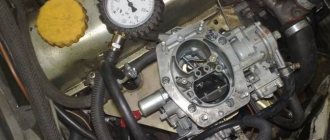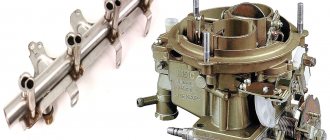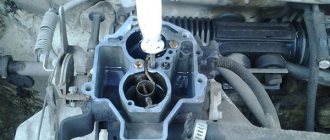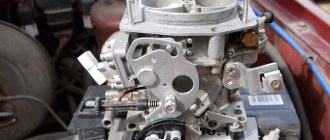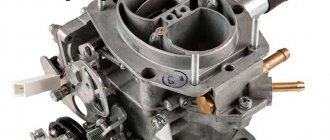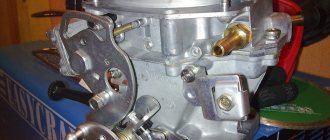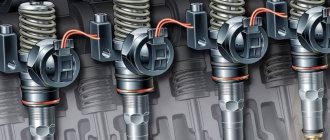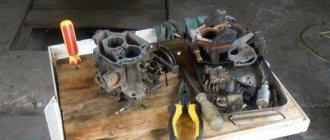Among the huge number of cars with injection engines, you can still find carburetor power plants on our roads. The constant rise in gasoline prices forces car owners to switch to gas fuel. The best option for a carburetor car is considered to be 2nd generation LPG. A specialist who installs gas equipment will help you insert gas into the carburetor and choose the right components. We’ll talk about what inserting gas into a carburetor is, and how to do it yourself, in our article.
Inset options
In the situation with 2nd generation HBO, the insertion of HBO into the carburetor may vary, and depends primarily on the model of the car. For each specific case, experts consider the most optimal option:
- A simple way is to install a spacer mixer with a divider between the chambers. It is not intended to be inserted into the carburetor body. No need to drill anything. In this way, gas is often inserted into the ozone carburetor. It is necessary to remove the textolite gasket and install the gas mixer. This manipulation can be done with classic types of carburetors. The gas mixer is equipped with a power register. Has two outputs with autonomous adjustments. The register performs a useful function for fine-tuning the gas supply. You can effectively adjust the dynamic characteristics and save gas fuel. This option is very popular due to its simple installation.
- Another simple way is using a faucet, which car owners nicknamed the turtle because of its appearance. There is no need to remove the carburetor during installation. Unscrew the fastening nuts on the air filter, remove the pressure plate and install the turtle. Then all that remains is to put back the unscrewed nuts. The only modification is that you need to drill out the entrance for the gas line in the filter housing. The adjustment is carried out by a dispenser, which has an inlet and an outlet, as well as an adjusting bolt. You must be prepared for some loss of car dynamics when running not only on propane, but also on standard fuel. This factor is inevitable due to the narrowing of the air flow passage. It is possible to expand it by placing washers under the bolts. It will be more difficult to adjust the gas-air mixture using this method. It turns out to be “poor” or oversaturated. The advantage is simple installation. Suitable for all types, including ozone, daaz or weber.
- It is possible to insert into the LPG carburetor with separate adjustment. This is the way to install 2nd generation HBO on a Solex carburetor. The path is more complicated, but according to most experts, it is the most correct when it comes to connecting gas equipment. Such an insert is entrusted to installers or turners who are well acquainted with the principle of operation of the fuel system and have golden hands. You can “squeeze” the gas supply setting to the maximum from the obsolete HBO 2. In this case, a regulator is used with an autonomous fuel supply to the cameras.
The insertion method is considered the most difficult, but also the most profitable. However, inserting an LPG into a Solex carburetor is possible if the car owner is sure that he will not remove the gas, otherwise he will have to plug the insertion fittings.
Insert or spacer, what to choose?
Inserting gas fittings into a Solex carburetor is more beneficial from the point of view of saving fuel consumption and maintaining the dynamics of the internal combustion engine. The spacer has the disadvantage of blocking the air flow. However, there are types of construction in which it is impossible to physically make an insert or, conversely, install a spacer. For Solex it is definitely better to choose the way of introducing fittings.
If you need to maintain dynamics and maintain moderate fuel consumption, you can consider the option of a spacer mixer with a chamber separator, or use the insert option. If simple installation is important and you absolutely cannot tamper with the fuel system, the turtle is ideal.
Advantages and disadvantages
Let's summarize. There are certain advantages that come with installing a spacer mixer with a chamber separator:
- there is no need to make holes in the carb;
- you can fine-tune the gas supply dosage;
- engine dynamics are maintained;
- installation is not difficult.
The main disadvantage of this method:
- Suitable only for components of engine power supply systems of the “classic” series.
The advantages of the turtle mixer are obvious:
- very simple installation;
- Only the air filter housing needs to be drilled;
- Suitable for all types of carburetors.
Disadvantages of choosing a turtle for installing gas equipment that cannot be avoided:
- it is difficult to adjust the gas-air mixture;
- The engine dynamics are significantly reduced.
The most advanced method, but also the most difficult, is insertion. It has its clear advantages:
- significant fuel savings compared to the other two options;
- does not affect the dynamic characteristics of the engine;
- Can be installed on a Solex carburetor.
This method has one drawback, but it is significant:
- After modification, the carburetor cannot be returned to its previous state.
All three methods are available for HBO 1st, 2nd and 3rd generations. Definitely, the final choice is up to the masters of a certified center for installing gas equipment.
The carburetor spacer is a seemingly small part with holes. Installing this “thickened gasket” allows you to achieve increased engine performance while reducing fuel consumption, which is also important.
Equipping trucks and passenger vehicles with this part under the engine carburetor allows you to avoid many problems. When converting an engine to gas equipment, a spacer will be the best solution for equipping a carburetor engine, but even when the engine is running on gasoline, its work is indispensable.
Let's look at the benefits obtained by installing this equipment.
Which one to choose for the injector
The main disadvantage of installing an external slot mixer on an injection machine is that you often have to shorten the suction manifold pipe. Also, if a “cracker” mixer is installed, due to explosions, the valve bends in the opposite direction, which makes it difficult for air to pass through.
Mixer after cotton
There are cases of valve tearing off (a common problem with firecrackers with curtains attached to rivets). After which the remains of the rivets and the curtain fly under the intake valve, causing damage to the CPG.
Safety valve in manifold or filter housing
The solution to the problem is to install a flow mixer and separate installation of an anti-cotton valve in the plastic air filter housing. This design is less useful for protecting electronics because the blast wave will pass through the MAF/MAP sensors. Inserting a safety valve into the manifold (made of plastic) will work more efficiently.
Installing an in-line mixer will also require breaking the integrity of the pipe. This mixer is placed inside the corrugation with a hole cut for the fitting.
In terms of performance, all devices are designed for a specific car brand.
Several advantages of installing a spacer on a gasoline engine
The first and main thing is to prevent deformation when the engine body is very hot and to prevent the carburetor from overheating and disrupting the operation of the device. Models from brands such as Solex and Ozone are most susceptible to such “diseases”.
Here are some more benefits of installing a thick gasket when installing on a gasoline carburetor engine:
- If there is no spacer between the carburetor sole and the cylinder head body, the temperature is transferred to the device, strong heating occurs, so on a hot engine you will have to turn the starter for a long time before the engine grabs gasoline and starts. This occurs due to the acceleration of the evaporation of gasoline vapors; in addition, the specific density of the delivered fuel increases due to the high temperature and saturation of the combustion chamber with vapors;
- Having tightly tightened the nuts on the device to ensure a reliable connection and the impossibility of gasoline leaks, at the first heating the sole warms up and the deformation process begins. With subsequent inevitable heating, the deformation increases. Having removed the carburetor for repair, we get a deformed sole. This will cause the engine to run on three cylinders on a cold engine, and subsequently the engine will constantly fire. There will be air leakage along the lower flange and the intake manifold. Such a malfunction will require correction of the deformed sole; if the damage is severe, the sole or the carburetor itself will need to be replaced. Straightening the flange, and in case of severe deformation, milling - these works may involve a fuel supply system that is not equipped with a platform for the combustion chamber. None of even the most trendy sealants can help here;
- With many methods advertised on the Internet, a textolite sole under the carburetor, in the opinion of many car enthusiasts, should be installed on every car. However, you should be wary of fakes. You can often see a textolite spacer with an additional layer of unknown material on display. After a short period of time, it dries out or decomposes even worse, the performance and power of the engine drops due to a malfunction.
Faucet types
Based on their design, 2nd generation LPG mixers for injectors are divided into two types:
- streaming
- ring with holes or slotted (external/internal)
In-line and slot mixers (in corrugation)
Since injection engines are equipped with additional sensors at the intake, and the second generation of the gas system has a tendency to backfire, to protect the intake tract, mixers come with a built-in anti-pop.
Basic circuits for the carburetor:
- mixer on the housing lid
- spacer in front of throttle block
- inserts into the area of large diffusers
The operating principle is the same for all methods of gas supply. Due to engine operation, a decrease in pressure (vacuum) occurs in the intake system, while masses of air carry gas fuel with them. The more the internal combustion engine sucks in air, the more gas enters the combustion chambers.
The design of the mixer is made in the form of a diffuser, which facilitates mixing of fuel with air.
Carburetor problems when the engine is running on gas
Most often, owners of cars with a high level of gasoline consumption switch them to gas. Let us give as an example the option of switching a Gazelle gasoline carburetor engine to bottled gas.
In this case, problems await every driver of this equipment. The most basic of them is long and hard work, which sometimes leads to charging the battery when starting in the cold season. When installed on cars with balloon equipment, spacers are usually placed between part of the throttle valves and its main body.
When the distance between the 2 parts of the carburetor increases due to the installation of a thick gasket, the operation of the starting system on a cold engine is disrupted. It works uncertainly, as drivers say, “it doesn’t grab hold,” so the foot constantly presses the gas pedal, while the hands are busy with the ignition key and the choke handle.
When running on gas in the summer, a loose choke does not affect the starting of the car, but starting a cold engine in winter is done only on gasoline. With constant vibration, the car's threaded connections loosen, and the screws securing the carburetor flap axles loosen.
However, any motorist can easily get rid of this problem. To do this, it is necessary to make some changes - we weld an additional bar to the air damper rod. This change allows us to compensate for the difference in the distance of the classic (original) gasket between the parts of the carburetor and the installed gas spacer.
Inserting gas into the carburetor: advantages and disadvantages
Installation of a spacer mixer with a chamber divider has several positive qualities:
- no need to drill holes in the carburetor;
- it is possible to fine-tune the gas supply;
- the dynamic characteristics of the engine do not change;
- easy installation.
The main disadvantage of this option is that it can only be installed on classic engines.
The positive properties of the “turtle” mixer include:
- easy installation;
- holes are made only in the air filter housing;
- can be installed on any carburetor model;
With all its advantages, the “turtle” also has several negative qualities:
- complex adjustment of the gas-air mixture supply;
- dynamic characteristics deteriorate.
The most complex and advanced option is considered to be inserting gas into the carburetor. It has several advantages:
- high efficiency;
- does not affect engine dynamics;
- There is a possibility of installation on Solex.
The only serious drawback of this method is the impossibility of alteration. It will be very difficult to return everything to its original state.
Source
Which HBO is better to choose?
Any 1st or 2nd generation gas system is suitable for a car carburetor. Yes, at the moment there are already 3rd and 4th generations, but for this type of engine it will be useless. Since they differ from older models in the presence of electronics, and there are no corresponding sensors on a carburetor engine, and therefore it is not worth installing the latest models. They will automatically turn into 1-2 generations.
There are practically no differences between the first generation and the second generation HBO. The gas hose is connected to the carburetor through a spacer-mixer or through an insert into the carburetor. Under the influence of vacuum in the intake manifold, gas from the gearbox enters the carburetor through the dispenser. The only difference is the gas dispenser.
In the first generation, the gas dispenser is manual; it is set to the desired position once and requires virtually no adjustment. And the second generation has an electronic dispenser, with a valve that interacts with the engine depending on the readings of the oxygen sensor and the position of the carburetor throttle valve.
This second-generation system is not entirely suitable for classic cars. But you can easily make 1st generation HBO from it. To do this, simply replace the electronic dispenser with a mechanical one. For a carburetor, the first generation LPG will be the best option.
Types of mixers for 2nd generation gas equipment for carburetor and injector
Last updated April 1, 2022 at 11:51 am
Gas equipment of the 1st, 2nd, and 3rd generations on injection and carburetor cars operates on the principle of ejection. Gas is supplied to form the air-fuel mixture in such a system through an LPG mixer or an insert is installed.
In this article we will talk about methods of supplying gas fuel to the engine, which one is better to choose and how to install it.
Do-it-yourself HBO installation: instructions
When installing HBO with your own hands, we will use the following sequence:
- Installation of the cylinder;
- Gas pipeline wiring equipment;
- Installation of mixer and valves;
- Installation of gearbox and dispenser, control panel.
Once we have determined the plan and sequence of work, we can begin the installation itself. So let's get started.
Installation of the cylinder
Cylinders are produced in two types: cylindrical and toroidal (popularly known as tablets). For classic cars, a cylindrical cylinder is best suited, since such cars have a larger capacity. The best option would be to install the cylinder in the trunk, where there is a lot of free space.
For cars with a hatchback body, the trunk is located in the passenger compartment. Therefore, installing a cylindrical cylinder will not be the best option; it will take up a lot of space. Basically, such cars have a niche for a spare wheel. This is where the balloon should be placed, but not a cylindrical one, but a toroidal one (tablet).
The cylinder must be securely fastened. Otherwise, when moving, it will roll around and may damage the parts located on it. This can be done using a special stand and bolted metal strips.
Gas pipeline wiring
After installing the cylinder, we are engaged in wiring the gas pipeline. To do this, we drill a hole from the multivalve of the cylinder to the engine compartment. The gas pipeline should not pass through the cabin; it is better to run it along the bottom of the car.
It is better to drill a hole of a slightly larger diameter, insert a small piece of plastic pipe into it and secure it. This will provide additional ventilation for the multivalve.
We treat the inserted tubes with anti-corrosion mastic. Then you need to install the gas pipeline itself. It must be well secured and located as far as possible from the moving elements of the car.
Solex carburetor
There is the possibility of inserting a gas fitting into the carburetor for installing LPG, which has a separate adjustment. The second generation gas equipment is installed on Solex. This option is much more complicated. However, according to professionals, it is the best for installing gas equipment.
To adjust the fuel supply, there is a special regulator that provides autonomous gas supply to the chambers. The method of inserting gas into a Solex carburetor is considered the most complex, but very profitable. This option can be used under one condition. The owner of the car will never remove gas equipment. Otherwise, it will be necessary to plug the embedded fitting.
How to insert a fitting into a Solex correctly? To perform such a technological operation, you must adhere to a certain sequence:
- The carburetor is being dismantled;
- two holes are drilled in the chamber, and the most convenient place is chosen so that it is easy to connect and secure the gas tubes;
- the thread is cut with a tap;
- screw in the corresponding fittings;
- install and fix gas pipes.
The technological operation of inserting gas into a Solex carburetor must be performed with absolute precision. Such equipment is much easier to set up. It is very important that all parts included in the LPG kit are of high quality and produced by a well-known manufacturer. Assembly and installation should be carried out by a professional technician.
Remaking the Solex, when liquid fuel (gasoline) is constantly increasing in price, is completely justified. This is clearly visible when you have to make a large number of different trips by car. The savings are approximately 50%.


